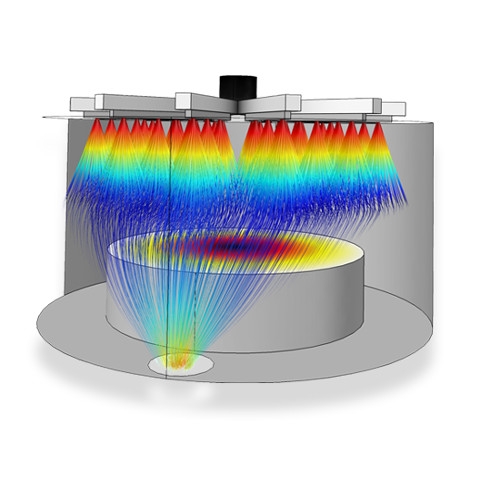Schedule a Call Back
Particle Tracing Module
Particle Tracing Module
Comsol Multiphysics Pvt Ltd offers Particle Tracing Module. The Particle Tracing Module extends the functionality of the COMSOL environment for computing the trajectory of particles in a fluid or electromagnetic field, including particle-particle, fluid-particle, and particle-field interactions. You can seamlessly combine any application-specific module with the Particle Tracing Module for computing the fields that drive particle motion. Particles can have mass or be mass-less. The movement is governed by either the Newtonian, Lagrangian, or Hamiltonian formulations from classical mechanics. Boundary conditions can be imposed on the particles on the walls of the geometry to allow particles to freeze, stick, bounce, disappear, or reflect diffusely. User-defined wall conditions may also be specified, where the post collision particle velocity is typically a function of the incoming particle velocity and the wall normal vector. Secondary particles released when an incoming particle strikes a wall can be included. The number of secondary particles and their velocity distribution function can be functions of the primary particle velocity and the wall geometry. Particles can also stick to the wall according to an arbitrary expression or a sticking probability. Additional dependent variables can be added to the model which allows you to compute quantities like particle mass, temperature, or spin. Particles can be released on boundaries and domains uniformly, according to the underlying mesh, as defined by a grid or according to an arbitrary expression. A wide range of predefined forces is available to describe specifically how the particles interact with the fields. You can then add arbitrary forces as defined by a suitable expression.
Product & Technology News
- Charged Particle Tracing interface to model ion and electron trajectories in electric and magnetic fields including elastic collisions with a background gas
- Particle Tracing for Fluid Flow interface to model the motion of microscopic and macroscopic particles in a fluid
- Mathematical Particle Tracing interface, which offers complete freedom over the equations solved
- Massless, Newtonian, Lagrangian, and Hamiltonian formulations
- User-defined forces
- Fictitious forces for rotating frames
- Particle-field interactions
- Reinitialization of the particle velocity vector based on some logical expression allows for general purpose Monte Carlo modeling

















